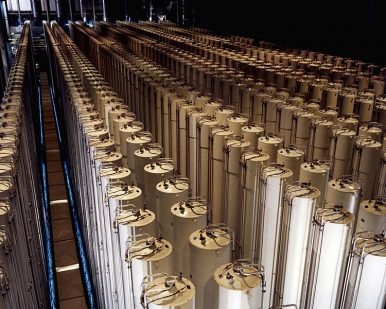By Ankit Panda
 Behrouz Kamalvandi, a spokesperson for Iran’s Atomic Energy Organization, spoke to Tasnim Newson Monday, clarifying the measures recently announced by Iranian President Hassan Rouhani pertaining to the country’s commitments under the 2015 Joint Comprehensive Plan of Action.
Behrouz Kamalvandi, a spokesperson for Iran’s Atomic Energy Organization, spoke to Tasnim Newson Monday, clarifying the measures recently announced by Iranian President Hassan Rouhani pertaining to the country’s commitments under the 2015 Joint Comprehensive Plan of Action.
Rouhani, on May 8, announced that Iran would cease complying with two provisions in the 2015 agreement, which sought to impose verifiable limits on Iran’s civil nuclear program in exchange for sanctions relief. Initially, Tehran will no longer keep its stockpile of low-enriched uranium (LEU) under the 300 kilogram limit permitted by the agreement. Furthermore, it will also not comply with the agreement’s limits on heavy water.
As I discussed in greater length recently at The Atlantic, Rouhani’s announcement was designed to point blame at the United States. The two specific provisions that went into effect regarding the LEU and heavy water limits came days after the U.S. State Department announced that Washington would sanction any individuals or entities involved in allowing Iran to comply with exports of excess LEU out of its borders in exchange for natural uranium (as allowed by the JCPOA). The Trump administration also said it wouldn’t permit any heavy water to become available to Iran “in any fashion.”
In this context, Kamalvandi’s remarks this week have received attention. The headline takeaway is that Iran is about to greatly increase its production of enriched uranium. The Associated Press, for instance, noted in its headline that Tehran would be quadrupling its production. That much is true, but the implications should be made clear.
First, the enrichment activity that is ongoing remains compliant with the JCPOA. Iran is not yet enriching uranium to levels greater than 3.67 percent uranium-235. Before the agreement, Iran was enriching to 20 percent uranium-235 — a much greater proliferation concern.
Kamalvandi’s core remark was that Tehran would be increasing the rate at which it produces LEU. What that means in practical terms is that it will shoot past the 300 kg LEU stockpile limit permissible by the JCPOA much faster. At one point, Kamalvandi implied that this could be done in as little as four days with the existing number of operational centrifuges.
All of that remains consistent with what Rouhani said with the exception of the clarification on the rate of production. Given that the Iranian president’s framing of the decision to cease abiding by the LEU and heavy water limits was designed to apply pressure on France, the United Kingdom, Germany, Russia, and China — the other remaining parties to the JCPOA — a greater rate of production could be yet another means by which to apply pressure.
Kamalvandi also underscored what Rouhani did: Time is running out and Tehran will make yet another decision regarding two further, much more consequential steps that are out of line with the JCPOA at the end of a 60-day period that began on May 8. At that point, Iran will determine whether it will resume enrichment to the 20 percent uranium-235 levels seen before the JCPOA was put into place and if it will reverse the modernization of the Arak heavy water reaction.
Both of these measures would decrease Iran’s possible breakout time to a bomb should a political decision to withdraw from the JCPOA and fully weaponize be made in the future. Each measure would also represent a significant violation of the JCPOA, possibly forcing the remaining parties to the agreement to invoke the sanctions “snap back,” effectively ending the core bargain at the center of the 2015 deal.
No comments:
Post a Comment